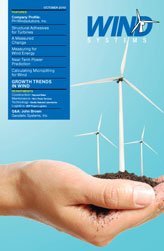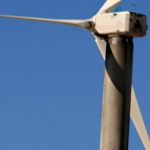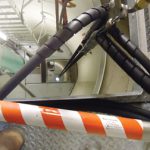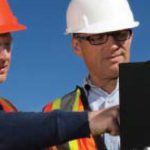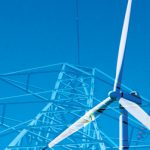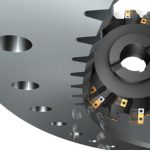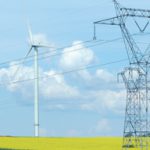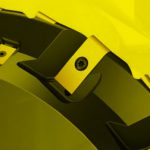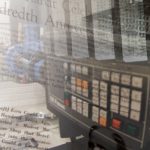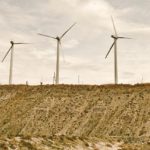Accurate, precise, and reliable measurements of wind speed and direction are critical in today’s increasingly competitive North American wind industry. Demand for reliable wind data is high, and manufacturers are responding with more equipment choices than ever before. As the size of wind turbines increase to 100m and beyond, finding the right mix of remote sensing technology to accurately measure the wind is becoming more of a challenge. New high tech sensor technologies using ultrasonic signals, radars, or lasers used exclusively in meteorological scientific research applications in the past are now being widely used in the wind industry as long life and reliability begin to overtake low cost as the primary consideration. Figure 1
Ultrasonic, radar, and mechanical sensors measure the wind in very different ways. The “cups” for speed and “vane” for vector change measurement physically move with changes in the wind and give readings of wind speed and direction. Ultrasonic sensors, or “sonics,” operate with no moving parts. On a typical ultrasonic anemometer a pulse of sound is transmitted by a transducer on the “north” facing side of the sensor. The time it takes to travel to the “south” transducer is accurately measured by a microprocessor within the sensor. The wind speed is calculated as a function of the time it takes the ultrasonic to travel to the opposite transducer. With no moving parts the measurement is immediate and precise. Sodar and lidar uses radar and lader respectively to measure wind speed at various heights. These also have no moving parts and can be moved around a prospective site, as they typically are in mobile a ground-based units.
Sodar and lidar use radar and laser respectively to measure wind speed at various heights. Sodar (sonic detection and ranging) systems are used to remotely measure the vertical turbulence structure and the wind profile of the lower layer of the atmosphere. Sodar systems are like radar (radio detection and ranging) systems, except that sound waves rather than radio waves are used for detection. Most sodar systems operate by issuing an acoustic pulse and then listening for the return signal for a short period of time. Generally, both the intensity and the Doppler (frequency) shift of the return signal are analyzed to determine the wind speed, wind direction, and turbulent character of the atmosphere [1]. Lidar is similar, but it uses laser light to detect changes in wind speed and direction.
When averaged over periods of time, sensor measurement accuracies are comparable. Any quality sensor (and qualities do vary) measure at the level reported in sensor’s published specifications. Data may be reliable and accurate when averaged over time, but mechanical sensors will not always reflect turbulence (rapid changes in wind speed and direction) and gusts due to the simple physical limitations of moving parts. A mechanical sensor is affected by the start-up torque of the moving cup and vane. Observed differences occur in measured wind speed because of the time it takes a mechanical sensor to physically start up or register a change in wind direction. An ultrasonic sensor is not affected by physics of inertia. It will measure a change in wind direction or a high gust immediately and in real time. Sodar and lidar are difficult to compare directly.
NWS Taking the Lead
The inability of mechanical sensors to measure sudden changes prompted the National Weather Service to initiate a widespread change to all its Automated Surface Observation Systems (ASOS) from mechanical to ultrasonic sensors. ASOS systems serve as the United States’ primary surface weather observation networks. There is a network of 883 ASOS weather systems installed throughout the United States. The majority of these are used for aviation services managed by the FAA. Data is public and available for use by anyone for reference purposes. The NWS initiated the weather sensor upgrade program in 2000 following a new requirement by the Federal Aviation Administration (FAA) stating that all sensors needed to be capable of measuring variable gusts at three second intervals. Mechanical sensors are not designed with this capability. Most can only measure rapid wind speed changes to five-second gusts.
Reliability was another stated reason the NWS decided to make the switch to ultrasonics. Al Wissman, the acting operations division director of the NWS says “there were mechanical deficiencies in the old sensors. Freezing was always a problem, and when the sensors froze they became inoperable or inaccurate. This is a huge problem when directing aviation” [2].
Not only are ultrasonic sensors often heated, but the ultrasonic pulse itself creates heat when operating. This prevents ice formation on the sensor transducer heads, even with a non-heated sensor. The upgrade of the systems from mechanical to ultrasonic wind sensing equipment was completed in 2005.
Ultrasonic sensors are ice resistant on tall towers and less susceptible to damage caused by falling ice. In a recent test conducted with Lufft brand ultrasonic wind sensors, these highly heated ultrasonics were proven to continue operation in extreme freezing rain and high wind conditions over extended periods of time as per MIL standard- 810F, the U.S. military standard for ice resistance. Future ultrasonic anemometers with intelligent interfaces will deliver added values such as an electronic compass and barometric pressure sensor. Virtual temperature comes as a standard measurement with the Lufft ultrasonic sensors. Lufft sensors were also proven corrosion and vibration resistant in similar MIL standard tests.
Wind developers will often use ASOS, along with other NWS data as reference when determining the feasibility of a project site. New site measurements from met towers are correlated with existing wind data from a geographical area and used to validate data. NWS data is used as a general reference since many wind developers currently use mechanical sensors to capture onsite wind data, there is an increasing problem of inconsistency when referencing the ASOS ultrasonic wind data for a region. When submitting a wind project for financial review, consistency of data is the primary point of consideration.
Wind Analysis for Site Assessment
Until the last few years, ultrasonic sensors and remote sensing (sodar and lidar) have been a secondary measurement for wind profilers. This is partially due to the perceived high cost and low concern for long lifecycles in the profiling and assessment market. Widespread use of mechanical sensors in the industry’s past has not only been a matter of price, but of historical precedent for industry accepted measurement standards. Mechanical sensors are the only ones certified as Class A. Class A or Class 1 is the term for a sensor meeting the MEASNET and/or IEC standards. The IEC and MEASNET qualify Class A devices for contractual applications, the verification with standards, and resolving disputes between the utility and end customers. Class A has become a common name for sensors in the wind assessment business since the standard was released. Only a handful of sensors are manufactured and calibrated to meet this specific regulatory standard for wind measurement, all of them mechanical.
Though mechanical sensors have a qualified international standard for performance, they do not always perform to that standard or do not meet all the qualifications. Issues of icing, start up speed, vibration and poor tolerance to high wind gusts are just a few of the maintenance pitfalls mechanical sensor users have grown accustomed to. One study put out by the Center for Renewable Energy Sources (CRES) reported that mechanical sensors need to be recalibrated after 12 months of use in the field [3]. This is due to the fact that they have difficulty withstanding impact of sustained wind over time and are susceptible to other environmental hazards.
Steve Kropper, CEO of Windpole Ventures, says that “If we look at a life cycle costs over five years, a cup anemometer with a calibration certificate may cost just $350, but as soon as it fails the anemometer looks expensive. It costs roughly $1,000 every time we have to climb a tower. Now each sensor costs $1,700. And that makes ultrasonics look like a smart buy. Further, regardless of cost sensor failure undermines the Windpole mission for dependable, real-time hub height wind resource data. So frequent cup sensor failure is not an option” [4]. Kropper contracted with GL Garrad Hassan on a 12-month study comparing ultrasonic anemometers with industry standard cup anemometers.
Wind Analysis for Turbine Control
The majority of large turbine manufacturers have gone to ultrasonic anemometers as a lower maintenance means of controlling a turbine’s pitch and yaw system. A turbine control anemometer acts as the eyes and ears of any wind turbine. Turbine control and project SCADA systems rely on this relatively small component to direct the turbine into the prevailing wind for optimal efficiency. When it is placed high atop a wind turbine, an anemometer with moving parts that freeze over or break off stop all data transmission to the turbine controls. A “met fault,” as it can be called in the SCADA world, brings a turbine down immediately. It is critical that a wind turbine cease operation if communication with the anemometer is interrupted. If a turbine continues to operate when it is not pointed directly into the wind, the shear across the turbine blades can cause damaging mechanical strain on the machine.
Any power that is produced during the time after a turbine shuts down for a met failure is not recorded by the SCADA control system. Less sensor reliability means decreased wind farm reliability and significant lost profits for owners and utilities. “Turbine anemometer failure events are not only bad for the owner, they are a nightmare for the utility,” according to one large Colorado Utility representative. “With more wind than ever feeding into the grid, this is true now more than ever.” It is clear that the wind industry’s eyes are turning to sensor reliability as linked to project reliability.
So which sensor is best for you? Turbine manufacturers and wind profiling/forecasting specialists still use mechanical sensors on a regular basis. These industry professionals claim that the data is more accurate and reliable as cup sensors. A mechanical wind sensor can be the right choice when considering [5]:
• A low-cost alternative;
• A situation where moving parts are preferred;
• A replacement to match an old mechanical system where a high tech upgrade is not desired;
• Data does not need to be logged or archived;
• A shorter life cycle for the sensor is not an issue;
• A system that requires extremely low power (<4VA).
Ultrasonics are a newer technology. Change is always a challenge, especially in an industry used to doing things fast and in a certain way. One leading developer who is familiar with both methods of meteorological measurement says that “Consistency and price are the main reasons the industry has been reluctant to switch over to ultrasonics… consistency that is changing now that the National Weather Service replaced their mechanical sensors with ultrasonics over five years ago” [6]. Although more expensive, ultrasonics are the best choice when considering:
• Measurement of 3D wind speed and direction is needed;
• Extreme accuracy is required;
• Maintenance free is a priority (such as on the top of a turbine);
• A long life cycle with little risk of replacement is desired;
• Extreme cold and environments where ice is prevalent.
Remote sensing such as sodar and lidar are finding more acceptance with wind prospectors who want to quickly assess a site with a compact moblie unit. There is still some uncertainty with data reliability and the industry has been slow to accept sodar or lidar as the sole source of measurement when financing a new wind power project. Sodar and lidar are advantageous when considering:
• Quick deployment for a cursury study of a larger wind site;
• Measurement at extremely high hieghts is desired without the construction of a tall tower;
• A portable system, sodar can gather wind data on an operating wind farm to predict maintence needs;
• A low cost compliment to installed met tower data or purchased tower data.
Mechanical, ultrasonic, and radar- and laser based technologies all hold their own place in an ever-adapting wind industry. While mechanical sensors are a time-tested and internationally regulated technology, the precision and maintenance-free aspects of sensors with no moving parts are bringing them into the spotlight as time goes on. The National Weather Service upgrade from mechanical to ultrasonics started a trend. However, the IEC specifically cites mechanical sensors for use in wind assessment. Time, research, and experience will show how the industry will accept growing use of ultrasonics, sodar, and lidar technology. For now it appears this new technology has found a firm and growing place for wind assessment and turbine control applications.
References:
1) Atmospheric Research and Technology, LLC, www.sodar.com/about_sodar.htm
2) Interview with Al Wissman of the National Weather Service
3) “Effects of long term operation on the performance characteristics of cup anemometers” Stefanatos, Papadopoulos, Binopoulos, Kostakos, Spyridakis-Center for Renewable Energy Sources (CRES) GREECE
4) Windpole Ventures LLC , Renewable Energy World , Posted May 6 2009
5) Comments and mechanical and ultrasonic wind sensors taken from ATS Technology of Canada, www.atstechnology.ca/wind_vs_mechvultrasonic.html
6) Interview with meteorologist Greg Brown of Element Power, Inc., www.elpower.com



















